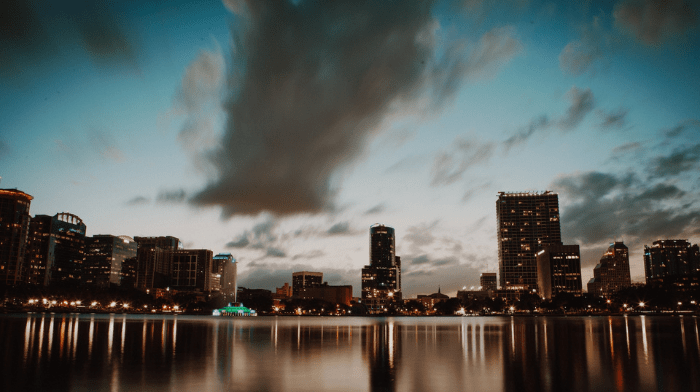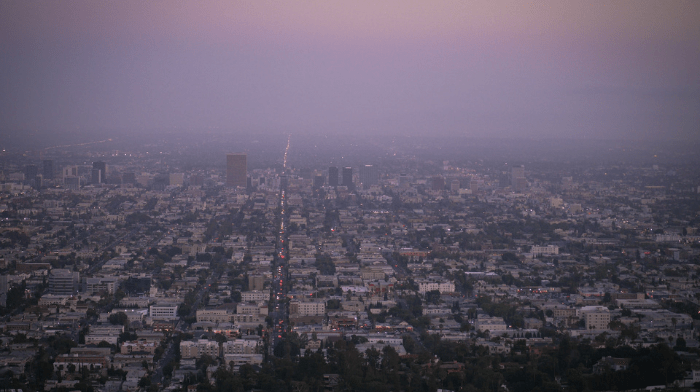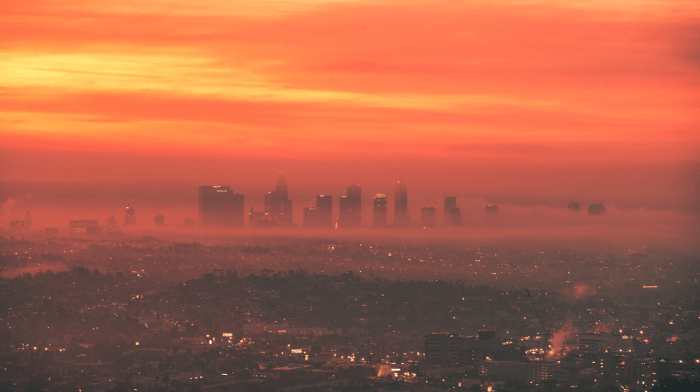In Search of Fresh Air: How Much Does Air Quality Affect U.S. Moving Trends?
Air pollution is sometimes an invisible threat people don’t know they’re exposed to. This summer’s Canadian wildfires and images of an orange-tinted, smog-filled New York City skyline put the topic front and center in many minds.
But outdoor air pollution is a risk that affects millions of people throughout the U.S. – whether they know it or not.
The U.S. cities that typically have the worst air pollution weren’t the ones affected by the Canadian wildfires this summer, though they may have dealt with wildfires closer to home. And some major cities with the best air quality in America may surprise you.
How much does air quality affect where Americans choose to live?
Not that much, actually. And this could be because it’s so hard to find a major U.S. city in 2023 where air pollution is not a concern.
moveBuddha compared the median Air Quality Index of the top 5 best and worst major metro areas for air pollution in 2023 with our proprietary moving trends data and U.S. Census population growth rates between 2020 and 2022. We narrowed down the metro areas we studied to ones with a population of one million or more as of the 2022 U.S. Census estimate.
We found that Americans are, on average, more interested in moving to the best cities for air quality in 2023 compared to the cities with the worst air pollution - but the differences are slight.
Table of Contents:
I. The 5 U.S. Metro Areas for Best Air Quality
II. The 5 Worst U.S. Metro Areas for Air Quality
III. Sources and Methodology
IV. Media Contact
Big Takeaways
- Fresh air, don’t care? On average, the five major U.S. cities with the best air quality have more moving interest and better population growth than cities with the worst air quality - but the margins are slim.
- Smog in the West. Four of America’s top five cities with the worst air pollution are in the West or Southwest, including #1 Phoenix, #2 Los Angeles, and #3 Denver.
- Deep breaths in Florida. Two of the best cities for air quality are in the Sunshine State, with #2 Orlando and #4 Jacksonville.
- Healthy Portlandia. Portland, Oregon, has the cleanest air of any major U.S. metropolitan area. The clean air hasn’t been enough to attract new residents, though, according to recent Census population data.
- Hot and polluted Phoenix. Phoenix has America’s worst air pollution among major cities, slightly more than #2 Los Angeles. Despite the heat and poor air quality, Phoenix continues to grow.
America’s 5 Best Major MSAs for Air Quality in 2023
Americans looking for clean air can consider the following five metro areas, two of which are in Florida.
#5 Buffalo, NY
Average 2023 AQI Value: 51.64
Maximum AQI Value Observed in 2023: 169
2023 Move In-to-Out Ratio: 0.75
Population % Change, 2020-2022: -0.7%
2023 Q2 Office Vacancy Rate: 17.4%
July 2023 Zillow Home Value Index (ZHVI): $216,470
1-Year ZHVI Change: +1.5%
Buffalo’s air quality is better than the worst cities in the nation, but it’s been worsening in recent years. The American Lung Association reported in 2022 that air quality across New York slightly improved. Upstate metro areas like Buffalo and Albany fell off the “cleanest cities” list for particle pollution.
Buffalo also had a rougher year for air pollution in 2023 because of the Canadian wildfires. For example, the city’s skyline was obscured in July by haze from Quebec wildfire smoke, bringing dangerous air quality days.
Is the worsening air quality affecting moving trends? It might be one factor. Buffalo’s moving ratio is 0.75 in 2023, according to moveBuddha. That means for every 75 people interested in moving to Buffalo this year, 100 want to move out. Buffalo also lost 0.7% of its population between 2020 and 2022. Air quality is better in Buffalo than in a city like Los Angeles, but it appears to be going downhill.
#4 Jacksonville, FL
Average 2023 AQI Value: 46.16
Maximum AQI Value Observed in 2023: 101
2023 Move In-to-Out Ratio: 1.65
Population % Change, 2020-2022: 2.3%
2023 Q2 Office Vacancy Rate: 19.5%
July 2023 Zillow Home Value Index (ZHVI): $295,177
1-Year ZHVI Change: -0.8%
Jacksonville’s air quality has improved steadily in recent years, so much so that the American Lung Association named it one of the cleanest cities in the U.S. for ozone air pollution in 2022. There’s still room for improvement, though.
The city’s short-term particle pollution worsened in 2021, so there were more unhealthy days. Particle pollution can be hazardous and shorten lives, and it generally comes from construction sites, unpaved roads, smokestacks, or power plants.
The improvements in Jacksonville’s air quality could be one reason more people are moving there. moveBuddha data shows a 1.65 move ratio for the Florida city this year, and Jacksonville’s population has grown 2.3% between 2020-2022.
#3 Virginia Beach, VA
Average 2023 AQI Value: 46.92
Maximum AQI Value Observed in 2023: 168
2023 Move In-to-Out Ratio: 1.16
Population % Change, 2020-2022: -0.8%
2023 Q2 Office Vacancy Rate: 8.4%
July 2023 Zillow Home Value Index (ZHVI): $388,713
1-Year ZHVI Change: +3.3%
Virginia has some of the cleanest air in the nation, and Virginia Beach is one metro area that benefits. The American Lung Association named four Virginia metro areas in the top 10 nationwide in 2022 for best for all three air pollutants, which no other state achieved.
Most of Virginia’s metro areas are relatively small, such as VA Beach, which has a 2022 estimated population of about 1.5 million. The small population size helps with air pollution, decreasing typical emissions sources.
Virginia Beach’s smaller size may remain, too. The metro area lost 0.8% of its population between 2020 and 2022, although moveBuddha data indicates a positive 1.16 move ratio in 2023. The lack of move-in interest may not be good for economic growth in Virginia Beach, but it’s good for cleaner air.
#2 Orlando, FL
Average 2023 AQI Value: 45.77
Maximum AQI Value Observed in 2023: 115
2023 Move In-to-Out Ratio: 1.67
Population % Change, 2020-2022: 2.7%
2023 Q2 Office Vacancy Rate: 14.4%
July 2023 Zillow Home Value Index (ZHVI): $372,442
1-Year ZHVI Change: +0.5%
Orlando doesn’t have the cleanest air in Florida. But compared to other big metro areas, the air quality in Orlando is pretty good.
The American Lung Association found in 2022 that Orlando’s rankings for particle pollution and ozone were mixed. But the ALA also ranked Orlando as one of the cleanest for short-term particle pollution for the sixth consecutive year.
University of Central Florida researchers say Orlando’s better-than-average air quality is partly due to the area’s flat coastal region. College Park and Baldwin Park have the best average air quality in the city.
As Orlando grows, it may need help maintaining its clean air quality. The MSA’s population grew by 2.7% between 2020 and 2022. More people, construction projects, vehicle emissions, and manufacturing facilities could soon change Orlando’s air quality for the worse.
#1 Portland, OR
Average 2023 AQI Value: 41.58
Maximum AQI Value Observed in 2023: 151
2023 Move In-to-Out Ratio: 1.2
Population % Change, 2020-2022: -2.7%
2023 Q2 Office Vacancy Rate: 19.9%
July 2023 Zillow Home Value Index (ZHVI): $538,106
1-Year ZHVI Change: -6.2%
Portland’s air quality may be clean compared to other major U.S. metro areas, but that doesn’t mean it’s pristine. Wildfires and the ongoing heat wave in Oregon have negatively impacted Portland’s air quality this summer, causing a buildup of zone pollution and smog-filled skies in the region.
Smoke from wildfires is a big problem that has affected a large portion of Western Oregon. The thickest portion of the smoke hasn’t extended as far north as Portland lately, though, and smog has mainly caused poor local air quality.
Nevertheless, Portland’s average AQI Value of 41.58 this year is still the best among major U.S. metro areas with populations of more than one million. If anything, this shows how prevalent air pollution is in American cities.
America’s 5 Worst Major MSAs for Air Quality in 2023
Americans wishing to avoid air pollution should be wary of the following five MSAs, four of which are in the West or Southwest. People sensitive to poor air quality include those with asthma or cardiovascular disease. If that’s you, the five cities listed below may not be a good fit for a move.
#5 Pittsburgh, PA
Average 2023 AQI Value: 63.43
Maximum AQI Value Observed in 2023: 212
2023 Move-In-to-Out Ratio: 1.08
Population % Change, 2020-2022: 0%
2023 Q2 Office Vacancy Rate: 15.7%
July 2023 Zillow Home Value Index (ZHVI): $229,643
1-Year ZHVI Change: -1%
The Steel City was once also known as the City of Smoke because of its air pollution. Pittsburgh has come a long way since then. But the city’s air pollution remains the worst in the nation east of Denver, especially for low-income residents who live near the remaining steel plants.
The American Lung Association says measures for Pittsburgh’s air quality worsened for 24-hour and year-round particle pollution but improved for ozone smog under the current EPA standard in 2022. The metro area’s score from ALA improved from an “F” in 2021’s report to a “C” in 2022.
Pittsburgh was also affected by Canadian wildfire smoke this summer. The smoke blanketed the area and created “code red” air quality days. The Steel City’s air quality woes could be why people have avoided moving there. moveBuddha data shows slightly positive moving interest in Pittsburgh this year, but the MSA’s population stayed neutral (0%) between 2020-2022.
#4 San Diego, CA
Average 2023 AQI Value: 65.92
Maximum AQI Value Observed in 2023: 140
2023 Move In-to-Out Ratio: 0.78
Population % Change, 2020-2022: -0.4%
2023 Q2 Office Vacancy Rate: 14.8%
July 2023 Zillow Home Value Index (ZHVI): $939,059
1-Year ZHVI Change: -2.8%
Most people think of San Deigo’s pleasantly moderate weather when imagining the city. But it may be surprising to learn that San Diego is among the most ozone-polluted cities in America.
The leading causes of San Diego’s harmful ozone pollution are heavy truck traffic and port activities. Wildfire smoke is another significant contributor, and the American Lung Association says that nine in 10 Californians live with polluted air.
Is this one reason why people are fleeing San Diego and California? Perhaps. Californians are leaving the state en masse for many reasons, including the cost of living and housing prices. San Diego is one California city struggling to retain residents, with a 0.4% population loss between 2020-2022.
#3 Denver, CO
Average 2023 AQI Value: 69.10
Maximum AQI Value Observed in 2023: 172
2023 Move In-to-Out Ratio: 1.51
Population % Change, 2020-2022: -0.3%
2023 Q2 Office Vacancy Rate: 22.4%
July 2023 Zillow Home Value Index (ZHVI): $563,324
1-Year ZHVI Change: -3%
Denver is known for its outdoor activities. But it’s been increasingly harder to enjoy the great outdoors in Denver in recent years as the air pollution has gotten worse.
Denver’s air quality has worsened since 2015, and the EPA recently downgraded the Front Range from a “serious” to a “severe” air quality violator. Most of the ozone pollution in the Denver MSA comes from vehicle emissions, industrial facilities, wildfires, and Denver’s unique topography that traps pollutants.
Climate change is making matters worse. It has prolonged Colorado’s fire season and created more hot days to trap pollution. Wildfire smoke plus locally-generated ozone have created some awful days of air pollution.
moveBuddha data shows Americans are still interested in moving to Denver, though primarily to suburban areas. But the toll of air pollution could be having an effect. The Denver MSA has grown by leaps and bounds in recent decades, but it experienced a slight dip in population between 2020 and 2022.
#2 Los Angeles, CA
Average 2023 AQI Value: 79.59
Maximum AQI Value Observed in 2023: 210
2023 Move In-to-Out Ratio: 0.92
Population % Change, 2020-2022: -2%
2023 Q2 Office Vacancy Rate: 22.9%
July 2023 Zillow Home Value Index (ZHVI): $907,874
1-Year ZHVI Change: -3.8%
Los Angeles’ #2 ranking on this list should come as no surprise - the city is notorious for a combination of particle and ozone pollution. LA’s air pollution is caused by a toxic cocktail of factors like emissions from vehicles, ships, planes, factories, and wildfires that continue to smolder yearly.
2023 hasn’t been any better for Los Angeles air quality, with an average AQI value this year of 79.59. That’s more than 10 points above #3 Denver.
There’s such a dizzying array of reasons Los Angeles’ air quality is so bad that it’s hard to know where to start. The yellowish smog that hangs in LA is ground-level ozone. It harms human health and can cause asthma attacks, strokes, heart attacks, and lung cancer.
In a state known for air pollution, Los Angeles has the worst. And it may be one of the many reasons people are fleeing the area. LA lost two percent of its population between 2020 and 2022.
#1 Phoenix, AZ
Average 2023 AQI Value: 80.77
Maximum AQI Value Observed in 2023: 342
2023 Move-In-to-Out Ratio: 1.12
Population % Change, 2020-2022: 2.3%
2023 Q2 Office Vacancy Rate: 26.1%
July 2023 Zillow Home Value Index (ZHVI): $412,023
1-Year ZHVI Change: -6.9%
Phoenix has the cards stacked against them in its battle for cleaner air. The metro area is in a sunny, hot desert, and the population has swelled. With more vehicles on the road, the transportation sector has been Phoenix's leading cause of air pollution problems.
Ozone pollution is a big problem between April and September, the hottest months in Phoenix. The ozone is formed when sunlight and heat interact with pollutants caused by vehicle and factory emissions.
Phoenix barely topped LA on this list, likely because of one incredibly bad AQI Value reading on July 26, 2023, when the PM10 value recorded in Hidden Valley was 342. There was a monsoon thunderstorm and dust storm that day, leading to an Ozone High Pollution Advisory.
The air pollution in Phoenix hasn’t slowed down growth in the area, though. The metro area has swelled in population for decades and grew 2.3% between 2020 and 2022. A summer of record-breaking heat and high ozone levels has tested the will of people with asthma, but Phoenix keeps growing.
Would You Avoid Moving to a City Because of its Poor Air Quality?
moveBuddha’s data shows that air quality isn’t a significant factor in where people choose to live. But that could be because finding a major U.S. metro area where air pollution isn’t a concern is difficult.
Some cities have much worse air pollution than others. But even metro areas like Portland, Oregon, with relatively clean air compared to places like Phoenix and Los Angeles, have challenges maintaining healthy air quality values.
According to the American Lung Association, about 25% of Americans (more than 119 million people) live with air pollution that can harm their health and shorten their lives. Air pollution is most prevalent in Western states and for low-income Americans, but it’s hard to find clean air in most U.S. cities.
moveBuddha’s examination of the top 5 best and worst major U.S. metro areas for air quality shows that air pollution may influence some moves, but the influence is generally small.
If Americans want to avoid air pollution, staying away from cities like Pittsburgh, San Diego, Denver, Los Angeles, and Phoenix is in their best interest. But even the cities we listed in the top five - such as #1 Portland and #5 Buffalo - struggle to maintain clean air.
Your best bet to avoid air pollution is to move to a much smaller town. If the population weren’t a factor in this study, some of the best American cities for air quality would be places like Fort Myers and Lakeland, Florida.
So, take a deep breath before you decide on your next move - your choice could mean the difference between fresh air and polluted skies.
Sources & Methodology
The move-in-to-out ratio data was collected from January 1, 2023, through June 8, 2023, and includes searches nationwide by individuals who were either planning to move or hire a moving company throughout 2023.
More information about our move data and in-to-out ratio equation can be found in our annual Migration Report.
The core air quality data for this report was taken from the EPA’s Air Data - Tile Plot. We calculated the average AQI value for each city by averaging the highest daily AQI values between January 1, 2023, and August 15, 2023.
The city population percent change data was taken from the U.S. Census Bureau’s Quick Facts page and was measured between April 1, 2020, and July 1, 2022, for all of the ten cities in the report.
The Zillow Home Value Index for all ten cities in this report is from Zillow data captured through July 31, 2023, and measures the ZHVI for all home types.
The 2023 Q2 Office Vacancy Rates were sourced from Cushman & Wakefield MarketBeat reports from each of the ten cities in the report.
Media Contact
Members of the media with questions about this report or who would like to cover it can contact:
Nick Pipitone
Communications Manager, moveBuddha
Email: nick@greenflagdigital.com
Not what you were looking for?
Check out other categories that can help you find the information you need!





